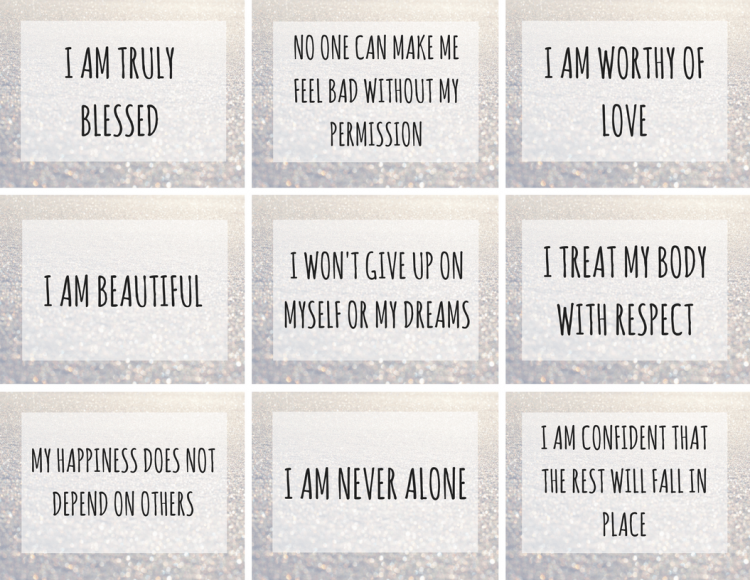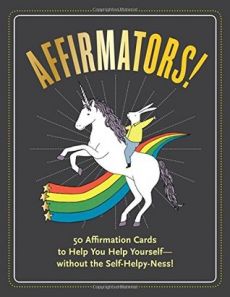Positive Affirmations for Success and Work: What it’s All About?

Anyone surfing through Twitter, Instagram or Facebook is sure to have come across the increasingly popular one line messages called affirmations. With the rise of social media, these positive affirmations have gone from the fridge magnet to cyberspace in one giant leap.
The idea behind them is that these words of encouragement or wisdom can help positively transform your mind or life. People are encouraged to repeat these positive statements as a way of reinforcing their message as some magic transformation. Now a lot of you may be thinking that it’s a lot of hogwash, but there’s a whole load of the science behind repeating positive affirmations, and the results the repetitions can bring.
The Science Bit
Using positive affirmations has nothing to do with magic; they mostly use the power of positive thinking to affect the brain. Using statements allow people to become receptive to change, and in a way, positive affirmations assist in that change.
A study carried out at John Hopkins University and published in the Psychological Science journal shows using daily affirmations make it easier for a person to make a positive change to their life. The repeated affirmations work like a primer of a pump, in this case, the brain.
Positive affirmations work by creating less anxiety and stress regarding the change that’s going to come. It also alters people’s perception of failure, or not meeting their expected goal, a bit like ‘falling off the wagon’. These affirmations make it acceptable to have a day off when trying to change a habit.

While many people use this as an excuse to quit because they think they can’t do it, the daily affirmations give motivation for when the going gets tough.
The repetition of positive affirmations can have a massive effect on the neuroplasticity of the brain. Yes it sounds very technical and a bit sci-fi but to put it simply neuroplasticity is the science surrounding rewiring the brain so it can think in different ways. We often say that people are set in their ways; well positive affirmations can break that so anyone can start thinking along new lines for personal improvement.
It’s the sort of thing children do all the time, but as we grow older it becomes harder and harder to change our thought patterns and processes. We need to make a conscious effort to get our brains thinking in a different way, rewiring if you like, and one of the best ways is through positive affirmations.
What are Affirmations?
An affirmation may just look like a good quote, but it is much more than that. It’s meant to be spoken out loud, and repeated as an encouragement to a person’s self-esteem, and gives them uplift. Positive affirmations are seen as a way of tapping into the language of the brain and usually follow a particular formula to work.
Three Elements
For a positive affirmation to work it must contain three elements, as without those it’s just a cool quote. Without the three elements the affirmation will not register with the brain, as it has pretty strict language rules.
✓ Always in the present tense. Your brain will only respond to affirmations in the present tense, so an positive affirmation that starts with “I will,” or “I’m going to,” won’t cut it as these are future tense, so are not likely to work.
✓ Only positive words. There should be no negatives in the positive affirmation, so words like “can’t,” “won’t,” or “don’t,” are not good to repeat. The idea is to give your brain a positive statement, and any negativity can cause confusion, and get the brain working overtime to turn into around into something good.
✓ A spoken statement of truth or fact. A positive affirmation needs to be a powerful and unequivocal statement, so words like “could,” and “might,” are not enough to cut it. A good affirmation needs words like “I am,”, and “I do.”
How Affirmations Work
The brain communicates in a specific way, and if you know how this works any positive affirmations you may use can be more powerful and effective. The complex communication network that constitutes the human brain is constantly receiving and sending information using cells called neurons.
Like a computer the brain takes what we say and thing in a literal way. Understanding this literal communication shows how our emotions are affected along with our behavior and physical wellbeing.
Literally Present Tense
When the human brain communicates it does so in the here and now, it’s not talking in the past or in the future, but always in the present tense. The brain is working at that moment. It is processing things in a split second and working what to do then and there. Your brain is taking in the information and preparing an action from the thought that goes with it. If you think you’re going to have a good time on the weekend, your brain immediately thinks about what to do to make it a great.

This immediate reaction gives you a boost of confidence. The interesting effect of this is that most people get a strong physical reaction to things even when they know they are fake. The emotions you feel when going to the movies are a good example. If the movie is scary then you might feel sweaty, frightened, or dizzy, and the brain may know it’s just a movie, but it is already processing the information as if it were real and preparing you for a perceived danger.
This is why positive affirmations need to be in the present tense. By keeping it in the present your brain is telling you to be positive and setting you up for positive outcome immediately not in the future.
The Positive Brain
Have you ever noticed that when emotions are triggered in the brain trying to be logical about things can have the exact opposite effect? Telling yourself not to get angry, or “Don’t cry,” can have the opposite reaction and make you feel more upset. This is because two things are happening to the brain and they both have a negative effect on your emotions.
If you tell yourself “Don’t cry,” the brain sees this as two instructions, one is “don’t” and the other is “cry.” We can hear the phrase and understand its meaning, but the brain hears the word “cry” and then wants to activate that command, and make us cry more. The command to the brain “don’t cry,” takes more processing by the brain, and it doesn’t give the brain an action to follow other than cry.
The brain is searching to do something else, but has not been given a command it can follow that will stop you crying. The answer is to say to yourself something positive that will make your brain act in a positive way. Next time try using the phrase “I am calm,” and see what effect it has.
The Brain in Focus
The brain operates using its own patterns and strict rules, which means it takes things literally. If there was not regulation within the brain it would process every piece of information it receives and act on it, and you’d be completely overwhelmed. Thus the brain has a function to filter information and guide your actions on only those things that need to be done immediately.
This autopilot system helps the brain and the body work more efficiently. If you’re hungry, it stops the brain processing every sound and smell it encounters deciding if it is food or not.
The brain filters out all the extraneous information and focuses in on what are potential sources of food. Think about being hungry and driving down the main street, the brain doesn’t look at every store, but tries to pinpoint stores that supply food.
The Brain will Decide for You
The human brain is constantly looking for clues on how to act from the environment around you, and is like a vacuum cleaner and picks up everything. Some of these cues are dealt with by the subconscious, but generally the conscious mind has a lot of control of the process.
Luckily for us the brain wants us to succeed, and all it needs are the instructions to do it, and that is what makes positive affirmation such a powerful tool for us to use to improve ourselves. So if you can give your brain a command in the simple language it wants to hear, then it’ll activate all the processes to make that happen.
Repetition is Key
When people use positive affirmations for the first time many feel very silly repeating them over and over. However, repetition is one of the most important factors in using this tool to create the life you want to live. The brain is a creature of habit and be repeating the positive reinforcements that come with affirmations.
Some people wonder why if the brain responds so well to present tense statements, why we need to keep repeating them several times a day. Well, by repetition you are strengthening the connections in the brain, and this helps it perform tasks with more focus and less energy.
It’s a bit like riding a bike, once your mind gets the hang of it, there needs to be no conscious thought, and it is all done subconsciously, and it is very natural.
Breaking the Tension
Affirmations are often about what you want to be not what you are at the moment, so to some people they can feel like you are lying to yourself. If you’re going to lose weight, the repeating affirmations such as “I have a perfect weight,” or “I love my body,” can feel as if you telling yourself a big lie. It feels unnatural to say those affirmations, and there is the temptation to change them to phrases you feel more comfortable with such as “I can stick to my diet,” or “I can lose weight.”
This temptation has to be resisted as they won’t be useful because they will not be following the three golden rules of positive affirmations. As naturally we don’t like tensions in our lives, and we spend our time avoiding and fixing the discomfort that comes with it. So, it’s no surprise people use ineffective affirmations as using one which will have some positive effect that may make them feel uncomfortable.
You have to realize that the discomfort you have when making a positive affirmation is one of the primary reasons it works. If you squirm with embarrassment when you repeat it, then it’s probably a good sign. What you want to do is to change your lifestyle to make the affirmation come true, rather than change the declaration to make it more comfortable.
What Can Positive Affirmations Help You With?
There is no end to the possibilities positive affirmations can do for your life; both men and women can use them to accomplish anything they desire and imagine. Most people want to change their attitude of themselves and use positive affirmations to boost their confidence and self-esteem.
However, the repetitions can also be used to attract more money, attract the opposite sex, create a positive relationship with someone, or even get you to lose weight and exercise more.
How to Create One
You can create your own positive affirmations by adapting any that are freely available to suit your particular situation. Remember the rules we set out earlier, and any affirmation needs to be in the language the brain will process without confusion. Make sure you only use positive words in your affirmations and refrain from using negatives such as can’t and won’t and don’t.
Every affirmation needs to be in the present tense, even if it sounds as if you are lying. Any discomfort you feel should be part of the motivation to make the change you want.

Make your affirmation relevant to what you want to achieve and keep it focused on your ultimate goal. When it comes to repetition, there’s no magic formula of how many times you need to do it per day, or how many times you need to repeat. Being focused when you make your affirmation is more important than the number of repetitions. Lots of people adopt a policy of three times a day when it is most convenient.
Repeating twenty times for up to five minutes is not unheard of. If you want to supercharge your affirmations, then you can gently touch a part of your body while saying them out loud. By doing this, you are creating a muscle memory associated with the positive thoughts and good feelings that come with positive affirmations. Your body will begin to remember the movement and touch associated with being positive.
Positive Affirmation Tools
There are lots of positive affirmation products on the market to help you create the right one for you. Here are a few items which can enhance your affirmations in compelling and exciting ways.
The Miracle Morning Art of Affirmations: A Positive Coloring Book for Adults and Kids Paperback

Here is something that can be used by adults and children together. Coloring in the pictorial representations of the affirmations allows you to concentrate on the meaning, and add personalization to each one. The authors say the therapeutic power of coloring can help you unwind, relax and empower yourself setting you up for success.
The affirmations are there to help you reach your life goals, make you happier and reduce stress and anxiety. This is a fun way to visualize your success in a way that can deepen connections with loved ones, and reinforce a positive mindset. The images have been specially chosen so they can enhance your vision of the future.
Mantras in Motion: Manifesting What You Want through Mindful Movement

Fitness and mind-body wellness expert Erin Stutland creates a 14-day routine to improve your self-reflection and movement. Her tri-fold approach to creating change harnesses the body’s physical, mental, and spiritual energy. Erin teaches you how to move your body while expressing your passion through the repeated positive affirmations, turning it into something more than an intellectual exercise.
Each chapter of the book breaks down one mantra in a way that allows you to focus on the goals of achieving success by unearthing your desires and removing any resistance. Each mantra is accompanied by life stories as well as movements and meditation to enhance their power.
Wonder Wall Calendar 2019

This 19-month calendar captures the spirit of the three New York Times bestselling books by author R.J. Palacio. Each monthly spread contains gorgeous illustrations of some of the author’s favorite quotes.
The monthly themes are thought-provoking enough to spark action and personal growth. The upbeat motivational approach is a call to action for anyone who wants to improve their lifestyle or health.
Positive Affirmations

How about setting your positive affirmations to music? Sunny Dawn Johnston has done just that with a collection of inspiring affirmations with a musical background. The album is available as a hard copy CD or a download if you prefer. Users say it is great for reinforcing the strengths that come with positive affirmations.
The album can be played anywhere; you can even use it on your commute to give you inner strength for the day ahead. The music is there to enhance the affirmations and doesn’t get in the way of listening to the mantras. The only criticism is that some of the affirmations have a negative structure.
However, these can be easily turned around into something more positive.
Affirmations! 50 Affirmation Cards to Help You Help Yourself – without the Self-Helpy-Ness! Cards

Here’s a handset of cards each with a positive affirmation to make your day better. They’ve been created by comedian Suzi Barrett, so they’re lots of fun and don’t have the cheesiness of a lot of affirmation cards.
The cards are enough to turn any pessimist into a more positive thinker. Users describe them as being both fun to read and highly inspirational, which can’t be bad.
The box of cards makes a great present for someone who is feeling a little low and needs a pick me up. The humor is good for older children and adults.
Pin for later

